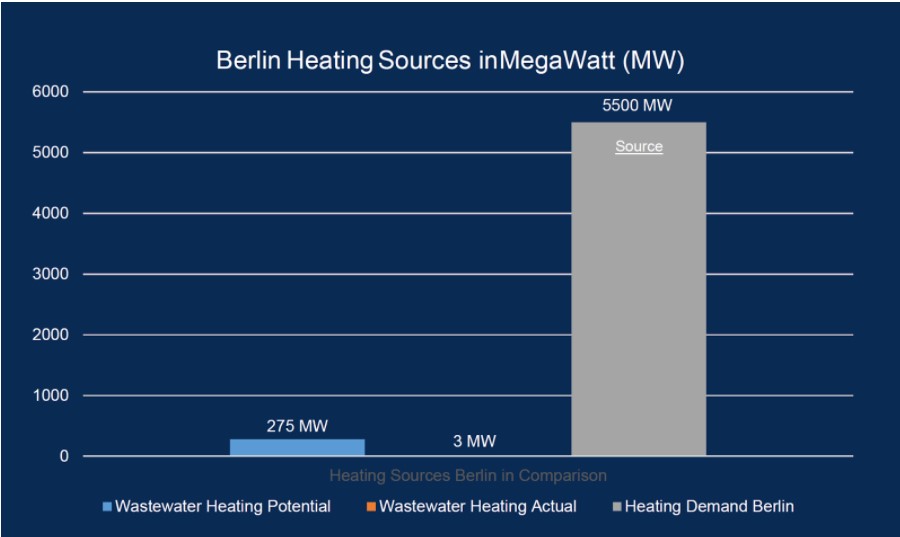Wastewater heat recovery
A large potential for climate-neutral heating
The Berlin team is specifically addressing the challenge described in the first blog post: to turn linear heating in metropolitan areas more and more into circular heating, this through a specific form: wastewater heat recovery.
Considering that the annual heat energy extraction power in Berlin is around 5,800 megawatts (MW), the potential extraction power of wastewater heat does not seem significant at first glance: around 275 MW. But as only about 3 MW are currently being utilized per year there is a large untapped potential of circular heating. Without it the “Wärmewende”, i.e. Berlin’s strategy for climate-neutral heating, would arrive much later.

How could it be otherwise in 2021? – data collection is key to success
The implementation of wastewater heat recovery can be supported in a number of ways. We are convinced that new hardware is not the best way to achieve this, because existing heat pumps – the central component of wastewater heat recovery – are a highly efficient and mature technology. The question is why only about 1% of the potential has been utilized in Berlin so far. – The answer lies in low knowledge about how to tackle the wastewater heat opportunity. It is particularly the lack of data that hampers a fact-based feasibility assessment. To solve this, the Berlin pilot team collects relevant data and bundles them in a web application that serves as an intelligent radar. It guides urban planners, real estate developers and initiatives towards more circular heating in Berlin.
Let’s start with data on geographical proximity to water infrastructure
During the project we learned that in order to find relevant locations (which means possible consumers) to implement wastewater heating systems, it is necessary to have access to some infrastructural and city structure base data. This includes a digital real estate cadastre from the city, a digital map of the existing infrastructure of the sewer system (provided by the water and waste-water suppliers). Now we need to combine and filter these fundamental data – for example deleting all real estates without heating needs, all open spaces, traffic infrastructure, storage units, etc. Resulting from this filtering is a map of buildings worthy to look at for installing wastewater heating systems. Now we try to find out which of those buildings are close enough to the existing wastewater infrastructure. Depending on the size of the wastewater pipes the radius of the catchment is different. After filtering we get to a reduced dataset to process in a subsequent step.
Next is figuring out where there is the biggest demand for energy
On top of data on geographical proximity to water infrastructure, an energy consumption rate table for those buildings is needed. This step is tricky. Since there are no wholesome open sources or publicly accessible datasets for this (energy supplying companies have a monopoly on this and no incentive to share data), we had to get this information on a city level from somewhere else. We decided to run a simulation which obeys the space of the buildings, number of levels, existing heat supply sources (gas, oil, distance heat, geothermal or solar collectors). On top of that, the construction year and with this the likely heat loss caused by the constructional deficits (used materials) and the state of renovations seemed relevant to us, as they have a reliable result for the theoretical heating needs of the buildings.
Finally let’s create matches drawing from both data pools
Combining the geospatial dataset with the attributional table of heating needs, we can run a dating-app-like process to find areas where an implementation of waste water heat systems seems to make sense both ecologically and economically. In order to make as many stakeholders as possible aware about these potentials, we are publishing them through a web service called the wastewater heat radar. Through this you are able to check if specific addresses qualify for the superior type of heating that wastwater heating is. As wastewater heating is not your typical consumer topic, we believe that the tool will be particularly useful for urban planners. We are even considering going a step further and promoting a proactive, semi-automated and widespread use of the application: basically, every property owner who has a share in promising “matches” could be informed about the possibility and offered further support. This seems particularly attractive from a city perspective. And the Berlin wastewater heat radar certainly lends itself to many other European cities. A blueprint for development is at least ready.

Let us introduce ourselves – Berlin’s wastewater heat team [Emoticon waving hand]
Berlin Water Management Agency – Berliner Wasserbetriebe (BWB) is the municipal water supply company in Berlin. It is responsible for water supply and wastewater disposal for Berlin and parts of Brandenburg and also supplies electricity through their subsidiary Berliner Stadtwerke. In the REFLOW project, Michel Gunkel and Heinrich Gürtler contribute expert knowledge and proprietary data from Berliner Wasserbetriebe. They are an essential part of the consortium because access to the city’s major water pipelines and the associated data, allows for an intelligent radar.
Prototypes for Europe e.V. – The Make & Think Tank, headquartered in Berlin, coordinates the pilot project and uses a variety of resources to do so: project management experience, technology transfer experience, and a great deal of know-how in the design and communication of technological assets. Expertise in GIS data is also proving valuable in the development of the application.
Fraunhofer FOKUS – The Fraunhofer Institute for Open Communication Systems FOKUS is an institution of the Fraunhofer-Gesellschaft zur Förderung der angewandten Forschung e.V. The institute specializes in applied research and development in the field of information and communication technology. As part of the Berlin Pilot, Public ICT experts Yury Glikmann and Vincent Bohlen contribute their deep understanding of software applications for public sector use cases.
MCS Data Labs GmbH – The SME specializes in IoT solutions and Big Data analytics. Consequently, the team led by Fihmi Mousa and Emilio Cuba, processes the data sets acquired from the project partners.
